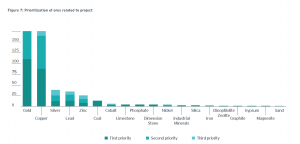Following two years of continued growth, exploration activities in British Columbia remained steady through 2019, with expenditures down less than a percentage point from 2018.
This, according to the British Columbia Mineral and Coal Exploration Survey carried out by the provincial Ministry of Energy, Mines and Petroleum Resources, the Association for Mineral Exploration and Ernst & Young, based on responses provided by 29 prospectors and 171 companies operating in BC, which collectively represent 326 projects across the province.

“The positive momentum gained between 2016 and 2018 has flattened out, with exploration expenditure shifting across the province’s regions,” the survey’s final report reads. “Investors continued to broaden their focus from gold toward copper, silver and nickel, as noted in the 2018 report. Exploration spend across the province totaled C$329 million, almost unchanged from the previous year of C$330 million but still an increase of 34% from 2017.”
According to the study, the behaviour of miners operating in British Columbia is consistent with the global shift from gold towards base metals. Decreases in gold were offset by increases in copper, whereas declines in coal were balanced by increases in nickel.
Back in 2018, gold accounted for 43% of total exploration expenditures, almost double that of copper. In 2019, however, investors shifted spending across commodities, with gold, copper and coal together contributing 82% to total spending.
Nationally, Canada’s exploration expenditure slid to fourth in global rankings — behind South America, Australia and Europe/Mainland Asia — for the first time since 2001
In detail, base metals comprised 39% of total exploration activity, accounting for C$143 million, an increase of 39% from the previous year. Copper was the leading base metal, contributing 72% of total metal spend, up from C$79 million to C$103 million, an increase of 31% year on year.
In the view of the experts behind the survey, such an increase in exploration for the red metal, particularly in the area known as the Golden Triangle, is likely driven by the global demand for electric vehicles and green energy.
On the other side of the spectrum, coal saw a 20% decline in investment, with all regions except the Northeast experiencing declines.
Grassroots and early-stage exploration accounted for 40% of total exploration in 2019 compared with 44% in 2018 and just 14% in 2014, as exploration spend moved to advanced and mine evaluation stages.
A look from the inside
In terms of the western Canadian province’s status when compared to other regions in the country, the survey found that BC saw a 16.8% decline in exploration expenditures in 2019 year-on-year, while Ontario saw a 9% drop and Quebec a 13% fall.
Internally, BC’s Northwest region continued to attract investment, whereas the Southeast experienced the largest decrease.
“The Golden Triangle of northwestern BC continues to attract exploration activity, as investors capitalize on high-grade discoveries supported by investment from major firms, partnerships with Indigenous groups and continued infrastructure development,” the report states. “Survey results reveal the region incurred C$180 million in exploration expenditure in 2019. That’s a 10% increase over the prior year and more than double 2016 levels.”
The document also shows that the Northwest accounted for 55% of total exploration spend in the province in 2019, despite the fact that gold exploration experienced a 39% decline in spending from 2018. Copper, on the other hand, exceeded gold exploration in the area and posted an increase of more than 150% from the previous year.
“Despite flat exploration figures in 2019, a shift in investments toward copper and other base metals provides reason for optimism in BC,” the study concludes.
